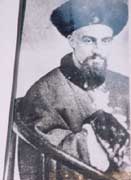|
The modern name giant panda can be attributed to the French missionary Armand Pere David (1826-19000), who lived in China for 12 years from 1862 to 1874. Preaching in Beijing and Shanghai, David was also a correspondent researcher of the National Museum of France. A natural historian, David has found 68 new species of birds, over one hundred species of insects, and many mammal species-including the Milu deer, golden monkey and the giant pandas- in various places of China. In March 1869, David came to the catholic church in Dengchigou of Muping (now Banshan County) of Sichuan and became the fourth preaching priest there. The Dengchigou Catholic Church was one of the earliest churches secretly built by the Cathedral Church of France in Sichuan.
In his journal, David writes: "On March 11, 1869, when I was on my way back to the Church, I was invited to have a rest in a Mr. Li's home. In his home, I saw the panda's skin. It's big and beautiful colored black and white. The skin was quite peculiar. Li told me that I would see this animal very soon, for his hunters were going to hunt this animal…it seemed that a new species in the science domain will be found…"
 In his Jounal of March 23, 1869, David writes: "After leaving for 10 days, the hunters were back today. They brought a young whitebear to me. It was caught alive, but was killed only to bring it back more easily." David pitied the death of the young panda cub, and he wrote on: "they sold the young whitebear to me at a very high price. The body of the whitebear was all white except that the legs, the ears and the places around its two eyes are black. It has the same skin color as a grown-up bear that I have seen before. I believe it to be a new species, not only because of its skin color, but also because of the hair beneath its feet and other characteristics. In his Jounal of March 23, 1869, David writes: "After leaving for 10 days, the hunters were back today. They brought a young whitebear to me. It was caught alive, but was killed only to bring it back more easily." David pitied the death of the young panda cub, and he wrote on: "they sold the young whitebear to me at a very high price. The body of the whitebear was all white except that the legs, the ears and the places around its two eyes are black. It has the same skin color as a grown-up bear that I have seen before. I believe it to be a new species, not only because of its skin color, but also because of the hair beneath its feet and other characteristics.
David sent this specimen of whitebear to Melne Edwards, the director of the Natural Museum of Paris, who studied the skin and skeleton of the animal and published a paper in 1870, announcing "in terms of external features, it is really very close to bears; but its skeleton and teeth are apparently different from bears---actually very close to raccoons. It must be a new species, and I name it Ailuropoda." Paying tribute to David's contribution, Edwards named the scientific name of the Giant panda as Ailuropoda melanoleuca David, which has been used utill now. The first giant panda specimen collected by David is still kept in the Natural Museum of Paris.
A study of Giant Panda's name history
World Interest in Giant Panda
|



